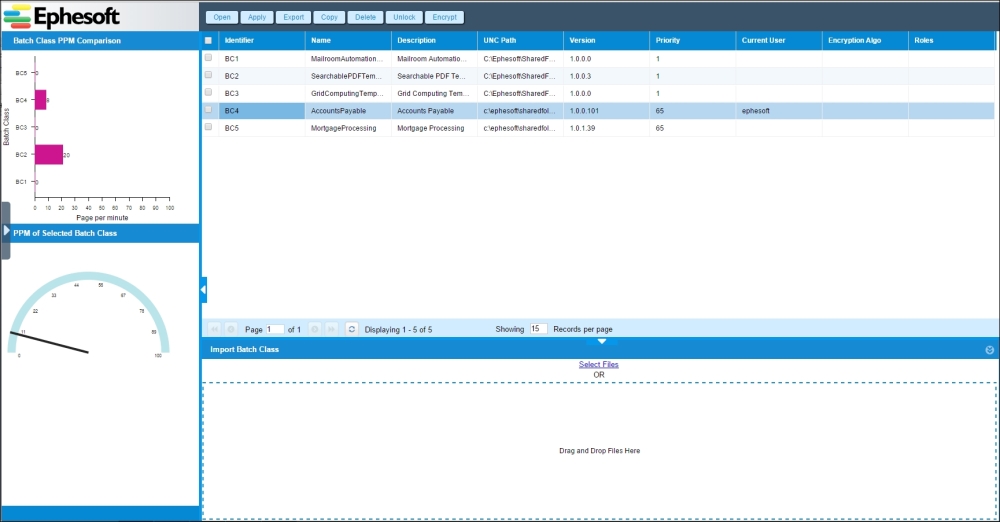The side navigation provides links to five areas of the system that are commonly used by administrators:
A batch class defines a set of operations that should be performed on the page images that are provided as input. A batch class consists of document types, document fields, batch class fields, e-mail configuration, and workflow/plugin configuration. The Batch Class Management interface allows administrators to create, modify, edit, and delete batch classes.

Ephesoft's batch class management user interface
The batch class management interface displays a list of batch classes. Administrators can open a batch class to configure the following:
Document types: The documents that will be processed in the batch class are configured here. Each document type is described by a distinct set of properties called fields. Rules can be configured to extract information from the document into the fields, thereby automating the process of indexing the document.
Modules: Modules are the major steps in the processing of documents. Each module is implemented by a series of plugins.
E-mail configuration: In this portion of the administrative interface, users can provide connection information for an e-mail account, and Ephesoft will process e-mails sent to this address. Ephesoft processes both the e-mail body and the attached documents.
Scanner profiles: This is where administrators can associate one or more scanner configurations with each batch class. These profiles are available in the web scanner.
CMIS import: CMIS is a standard protocol for communicating with document repositories. Ephesoft can use CMIS to monitor a standards-compliant document repository for input.
Batch class fields: Ephesoft can associate information with a batch (the group of page images that are processed together) as a whole. Each piece of information associated with a batch is called a batch class field. Batch class fields are applied to batches and should not be confused with document fields, which contain information that applies to individual documents.
A batch instance is a set of page images processed together. The terms batch and batch instance are usually interchangeable. This area within the administrative interface allows administrators to see the status of batches, reprioritize batches, and restart batches in a previous processing step.

Ephesoft's batch instance management user interface
The folder management interface allows the administrator to upload files for batch class configuration. These files are also accessible from the installation folder, but this is often a more convenient way to manipulate these files.

Ephesoft's folder management user interface
This administrative interface allows users to manage Ephesoft in ways that are not specific to a batch class or instance.

Ephesoft's system configuration user interface
System configuration allows the modification of the following features:
Regex pool: The regular expression pool is a library of regular expressions that administrators can access when creating extraction rules for a batch class.
Workflow management: Ephesoft's features are implemented in components called plugins. The workflow is the sequence in which these plugins are executed. This portion of the user interface allows an administrator to specify what plugins are available when configuring the workflow for a batch class.
Connection manager: The connection manager allows you to create and test database connections. These connections are used by plugins to access databases.
License details: This allows administrators to see the expiration date of the license and the features that are enabled.
Reporting can be enabled to provide administrators with statistics on the system and throughput. The administrator can filter reports by criteria such as batch class or start date. Advanced reports are also available, including correction reporting. Correction reporting identifies when operators made corrections to Ephesoft's automated processing. This information can be used to optimize the configuration over time.

Ephesoft's reporting user interface



